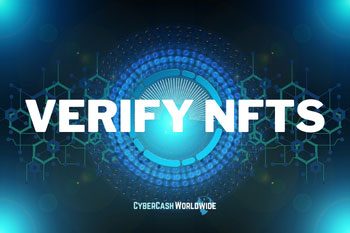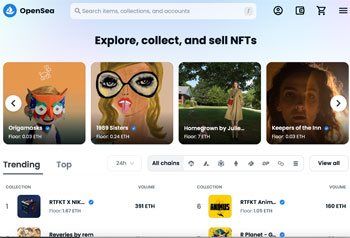Non-fungible tokens (NFTs) seem to be used to represent anything from art to collectibles to in-game items. So are there ways to make money by creating and selling NFTs? What are the popular ways? Find out if there are some opportunities that non-techies like us can take advantage of and whether it’s worth taking time and effort to learn it all.

What Is An NFT?
An NFT is a type of digital asset that is non-fungible, meaning it cannot be replaced by another identical asset. NFTs are verified on a blockchain, which is a distributed ledger that records all transactions made on the network. NFTs are often used to represent items in video games or other digital worlds and can be bought, sold, or traded like other virtual assets. However, unlike other virtual assets, each NFT is unique and cannot be replicated.
NFTs have been gaining in popularity in recent years as a way to collect and trade digital items. Some popular examples of NFTs include Cryptokitties, Decentraland, and Gods Unchained cards. NFTs can be stored in online wallets or exchanges and can be bought or sold using cryptocurrency.
NFTs and Blockchain
NFTs are stored on blockchains, which are distributed ledgers that record all transactions made on the network. Blockchains use cryptographic techniques to ensure that each transaction is secure and cannot be tampered with. This makes NFTs very safe and secure to use.
How NFTs Are Verified on Blockchain
When a new NFT is created, it is verified by the blockchain to ensure that it is genuine. This verification process is essential to prevent counterfeiting and fraud.
There are two main ways that NFTs are verified on blockchain: through digital signatures and cryptographic hashing.
Digital signatures are used to verify the identity of the creator of an NFT. Every NFT has a unique digital signature that is generated when it is created. This signature can be used to verify that the NFT was indeed created by the person who claims to have created it.
Cryptographic hashing is used to verify the contents of an NFT. Every NFT has a unique hash that is generated when it is created. This hash can be used to verify that the contents of the NFT have not been tampered with.
The Benefits of Verifying NFTs on Blockchain

When it comes to digital assets, verification is key. NFTs are no different. By verifying NFTs on the blockchain, you can be sure that they are genuine and have not been tampered with.
This is important for a number of reasons, such as;
- It protects the value of your NFTs. If someone were to create a fake NFT and try to sell it as the real thing, you would be able to spot it right away if you verified it on blockchain first.
- Verification can help prevent fraud. If someone tries to charge you for an NFT that doesn't exist, or tries to sell you an NFT that has been tampered with, verification will help you catch them in the act.
- Verification gives you peace of mind. Knowing that your NFTs are genuine and have not been tampered with will allow you to enjoy them all the more.
So how exactly do you verify an NFT on the blockchain? The process is;
- Find the NFT's blockchain address. This is typically easy to find, as most NFTs will display their address prominently on their website or in their listing.
- Use a blockchain explorer to look up the NFT on the blockchain. A blockchain explorer is simply a website that allows you to view transactions and other data on a blockchain. Reputable blockchain explorers include BlockCypher or Etherscan. Both of these explorers are easy to use and provide all of the information you need to verify an NFT.
- Once you have found the NFT on the blockchain, take a look at the transaction history. You should see a list of all of the times that the NFT has been transferred. If everything looks correct, then you can be confident that the NFT is genuine.
Of course, it's also important to make sure that the NFT you're verifying is actually worth something. Just because an NFT is verified doesn't mean that it's automatically valuable. Do your own research to determine whether or not an NFT is worth your investment.
The Drawbacks of Verifying NFTs on Blockchain
There are a few potential drawbacks to verifying NFTs on Blockchain.
- The process could be quite slow, as each NFT would need to be verified on the blockchain individually. This could create a bottleneck in the verification process, especially if there are a large number of NFTs that need to be verified.
- It may be difficult to verify the authenticity of some NFTs, particularly if they are very old or have been through multiple hands. Without a central authority confirming their authenticity, it could be hard to trust that an NFT is genuine.
- It could be quite expensive. If each NFT needs to be verified on its own individual blockchain, the costs of doing so could add up quickly.
How to Verify Your Own NFTs on Blockchain
The verification of an NFT is a two-step process that begins with the minting of the NFT and then continues with the verification of the NFT on the blockchain.
Step 1. Minting:
The minting of an NFT is the first step in the verification process and it involves the creation of a unique cryptographic key for each NFT. This key is used to identify and track the NFT on the blockchain.
Step 2. Verification:
The verification of an NFT on the blockchain is done by checking the cryptographic key associated with the NFT against the blockchain's records. If the keys match, then the NFT is verified and can be traded or sold.
Summary:
In order for an NFT to be verified on the blockchain, it must first be registered with a smart contract. Once the NFT is registered, it will be assigned a unique ID that can be used to track it on the blockchain. The NFT can then be transferred to another user by sending the appropriate amount of cryptocurrency to the smart contract associated with the NFT. Finally, the new owner of the NFT can verify that they are the rightful owner by checking the blockchain for their unique ID.
How to Make Money with NFTs

One of the most popular ways to make money with NFTs is by creating and selling your own digital artwork. If you're an artist or graphic designer, you can create digital artwork and then sell them as NFTs. This is a great way to monetize your creativity and skillset.
There are some popular platforms that you can use to sell your NFTs which I have listed below. The process for selling an NFT on these platforms is usually pretty simple: just create an account, upload your NFT, set a price, and wait for someone to buy it.
You can also make money by investing in NFT-based projects and businesses. This is a bit more speculative than the other methods we've mentioned, but if you believe in the future of NFTs, investing in early-stage projects could be a great way to profit in the long run.
What Platforms to Use for Selling NFTs
NFTs can be sold on a variety of platforms, including online marketplaces, dedicated NFT platforms, and even some traditional online art galleries.
The most popular platform for selling NFTs is probably OpenSea, which is an online marketplace that specializes in NFTs. OpenSea has a wide selection of NFTs from a variety of creators, and also supports a number of different crypto assets, making it a good option for those looking to diversify their portfolio.
Another popular option is SuperRare, which is one of the leading platforms for digital art. SuperRare features some of the most well-known digital artists in the world and allows users to buy and sell both single pieces and collections of art.
There’s another platform called Rarible. Dedicated NFT platforms like these are a great option for those looking to get involved in the growing world of NFTs, but there are also a number of traditional online art galleries that are beginning to support the sale of NFTs.
Some of the most notable include Christie's, which auctioned off "Everydays: The First 5000 Days", an NFT-based digital image collage piece by Mike Winkelmann (better known as Beeple) for over $69 million in March 2021.
So, whether you're looking for a specialized NFT platform or a more traditional online gallery, there are plenty of options available for selling your NFTs.
What Types of NFTs Are in Demand?
NFTs are in demand for a variety of reasons. Some people want to use them as digital collectibles, while others see them as a way to invest in the future of the internet. Here are some of the most popular types of NFTs:
1. Cryptocurrency NFTs: These NFTs are based on blockchain technology and can be used as a form of digital currency. Bitcoin, Ethereum, and Litecoin are all examples of cryptocurrency NFTs.
2. Collectible NFTs: These NFTs are often used as digital collectibles. They can be anything from artworks to virtual worlds. CryptoKitties is one example of a collectible NFT.
3. Utility NFTs: These NFTs have a specific purpose or function. They can be used to access certain services or products, or they can represent ownership of an asset. Decentraland is one example of a utility NFT.
How Can You Price Your NFTs?
The first thing to do to price your NFT is perhaps to estimate the value of the underlying asset. If you're selling an NFT that represents a piece of digital art, for example, you'll need to factor in the value of the art itself.
You'll also want to take into account the rarity of the concept, or the class of the NFT. if the idea behind itself is so innovative that nobody’s heard of it before, then it will be more valuable. Then think about what buyers are willing to pay for your NFT. This will vary depending on each buyer's circumstances and preferences.
So the tips for pricing your NFTs are:
- Start by considering the value of the underlying asset.
- Take into account the rarity of the concept.
- Think about what buyers are willing to pay for your NFT.
- Use these factors to come up with a fair price for your NFTs.
Can You Buy and Resell NFTs?
Buying and reselling NFTs can be a good idea if you're carefully monitoring the value of Ethereum and keeping an eye on the particular NFTs you’re looking to buy and resell in the future. There are definitely some risks involved, for example, Jack Dorsey’s first-ever tweet. Mr Dorsey sold it for $2.9 million in 2021, the buyer listed the NFT for sale again at $48 million, but there were only 7 bidders, the highest of which was at 0.09 ETT ($277).
If you do your research and invest in NFTs that you believe will appreciate in value, then it may be possible for you to see some good returns at some point, but potentially you could lose it all for buying and reselling NFTs. Just like any other auction, there is never a guarantee.
Staking NFTs?

Staking NFTs
It’s possible that you can earn a passive income by staking (holding onto) NFTs. This can be possible provided that the NFT is expected to increase in value over time. There are a couple of other benefits for staking NFTs;
- Staking can help secure the network that your NFT is based on. By locking up your NFTs as collateral, you help raise the profile of the network and keep it running smoothly.
- Staking can also help unlock additional features or benefits that may not be available to non-stakers. Discounts on transaction fees or exclusive access to certain features, for example.
But of course, the value of your NFTs could go down, hence you could lose money. So, be sure to do your research and only invest what you can afford to lose.
And more importantly, when you stake your NFTs, you're essentially giving up control of them. So, if the platform you're using goes out of business or if something happens to your account, you could lose your NFTs entirely.
With all that being said, staking NFTs is one way to make money. Just be sure to weigh the risks and rewards carefully before making any decisions. You can stake NFTs by;
- Using Mintable, a service that allows you to stake your NFTs in exchange for minting rewards. This is a great way to get started with staking, as it doesn't require any additional setup on your part.
- Staking NFTs is through a platform like Ethereum's ETH2.0 deposit contract. It requires you to have some knowledge of how Ethereum works, as well as some ETH in your wallet to start with. However, it can be a more rewarding option than using a service like Mintable, as you'll receive a larger percentage of the rewards from staking.
- Using Stakehound. You simply deposit your NFTs into Stakehound’s wallet and it will handle the rest of the process for you. This is by far the easiest way to stake NFTs, but it comes at the cost of not receiving as high of rewards as other methods.
Really, Can You Make Any Money With NFTs?
You know by now that many different ways to make money with NFTs are out there, and the possibilities are really only limited by your imagination. As a digital artist looking to sell your work, or a musician looking to release your latest album as an NFT, there's definitely a way for you to cash in on this new and exciting technology. We hope this article has given you some ideas of how you can get started making money with NFTs - good luck!
Did You Know You Already Have A LOT To Sell?
So What's Your Problem?


